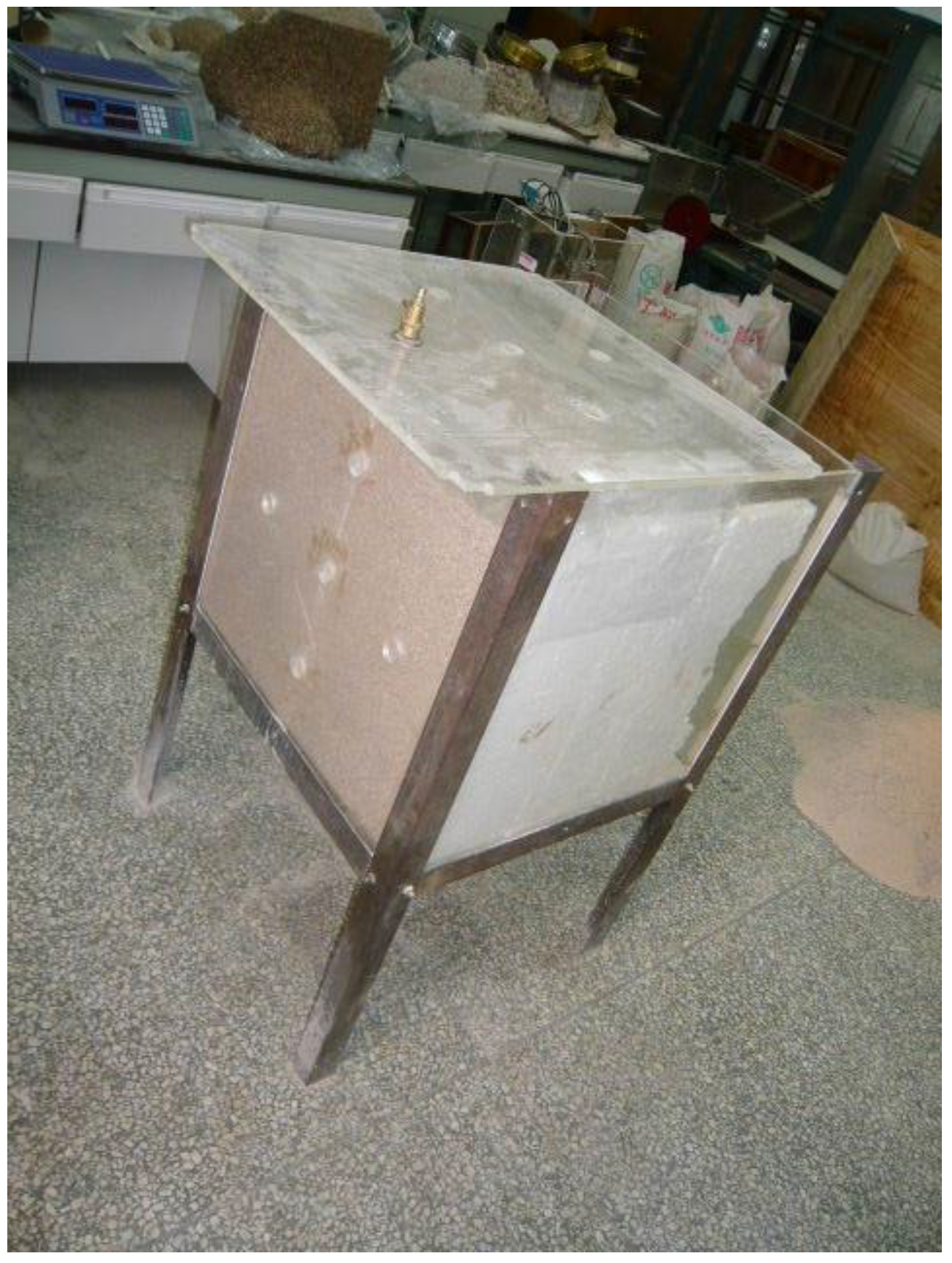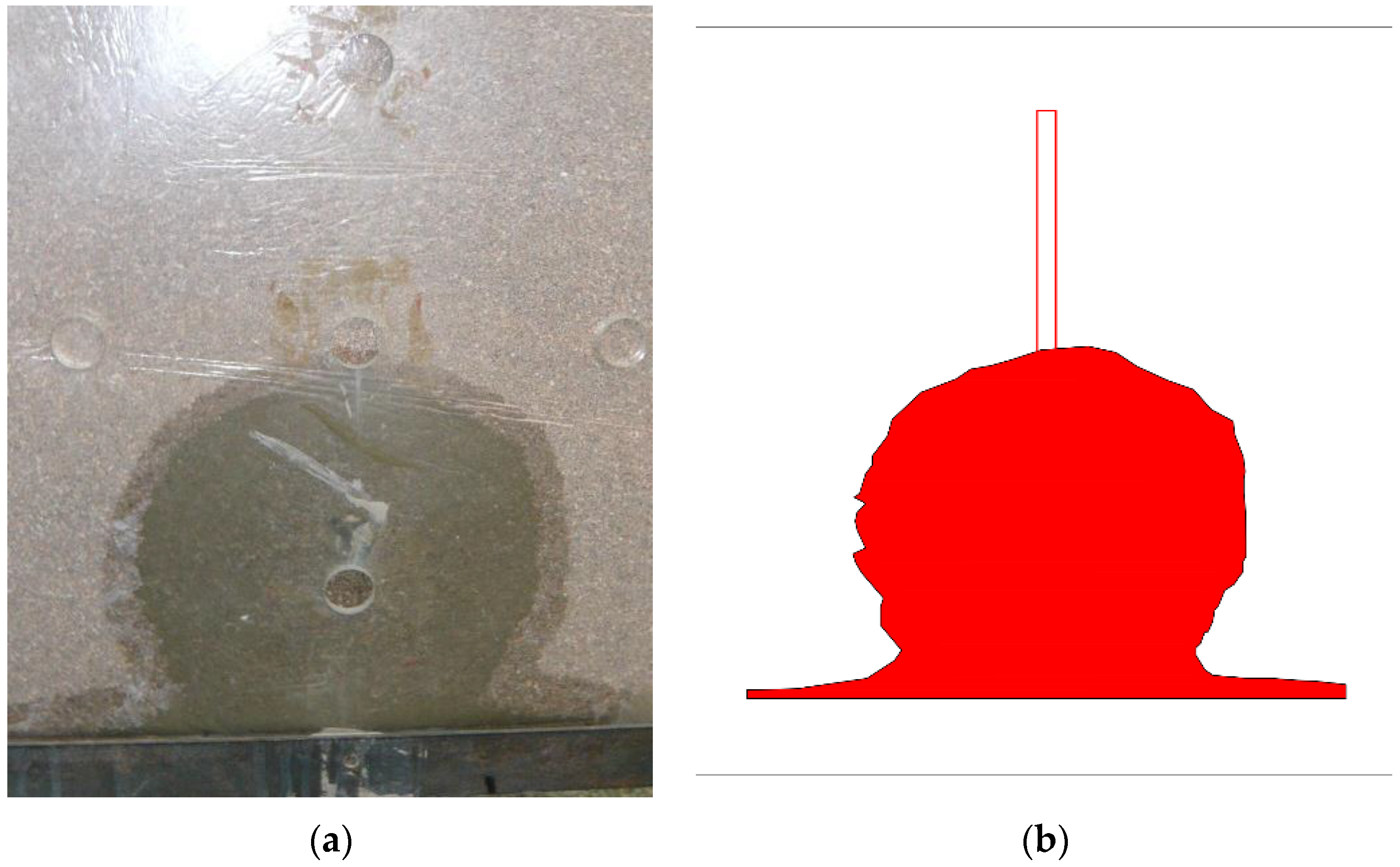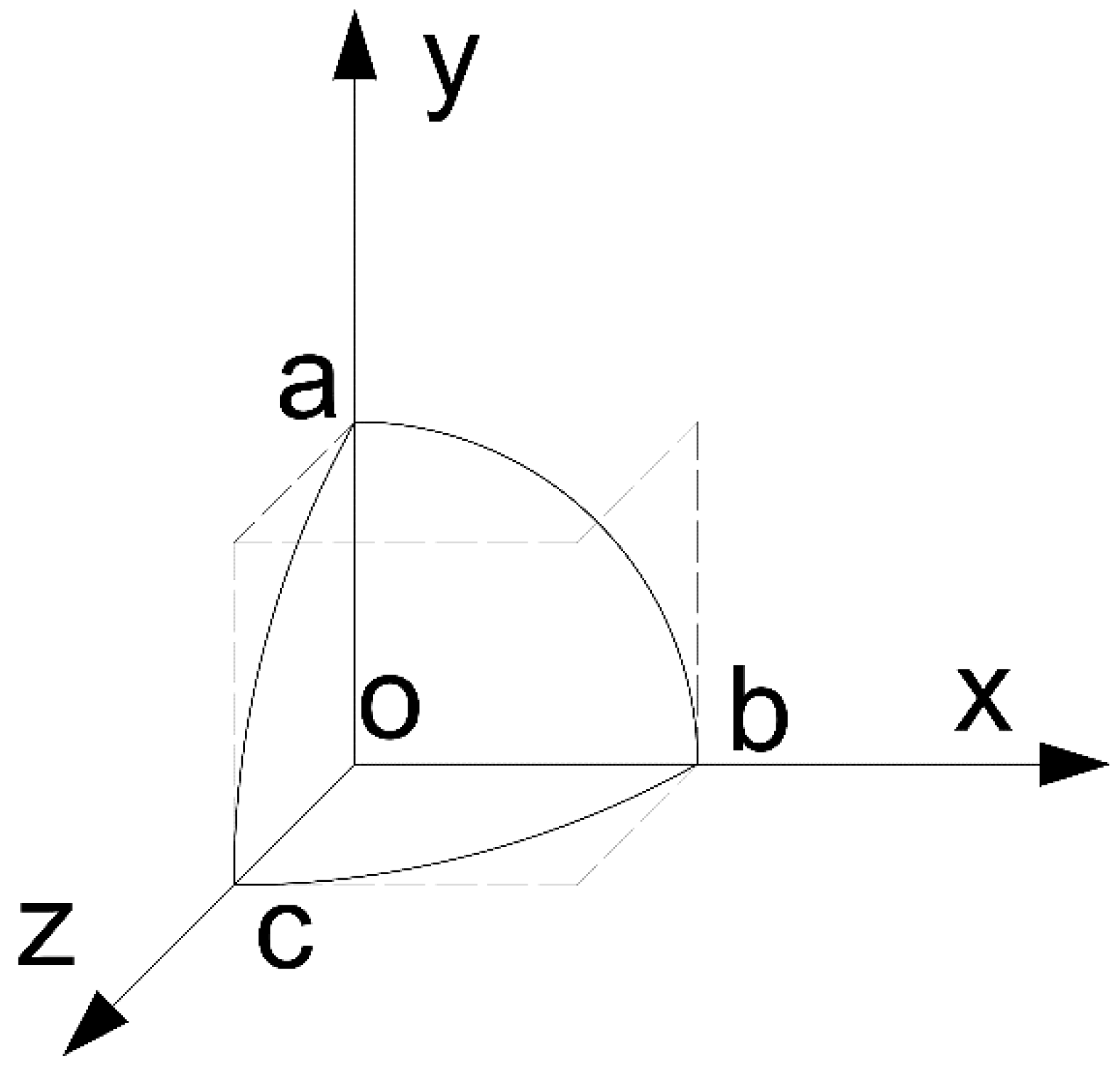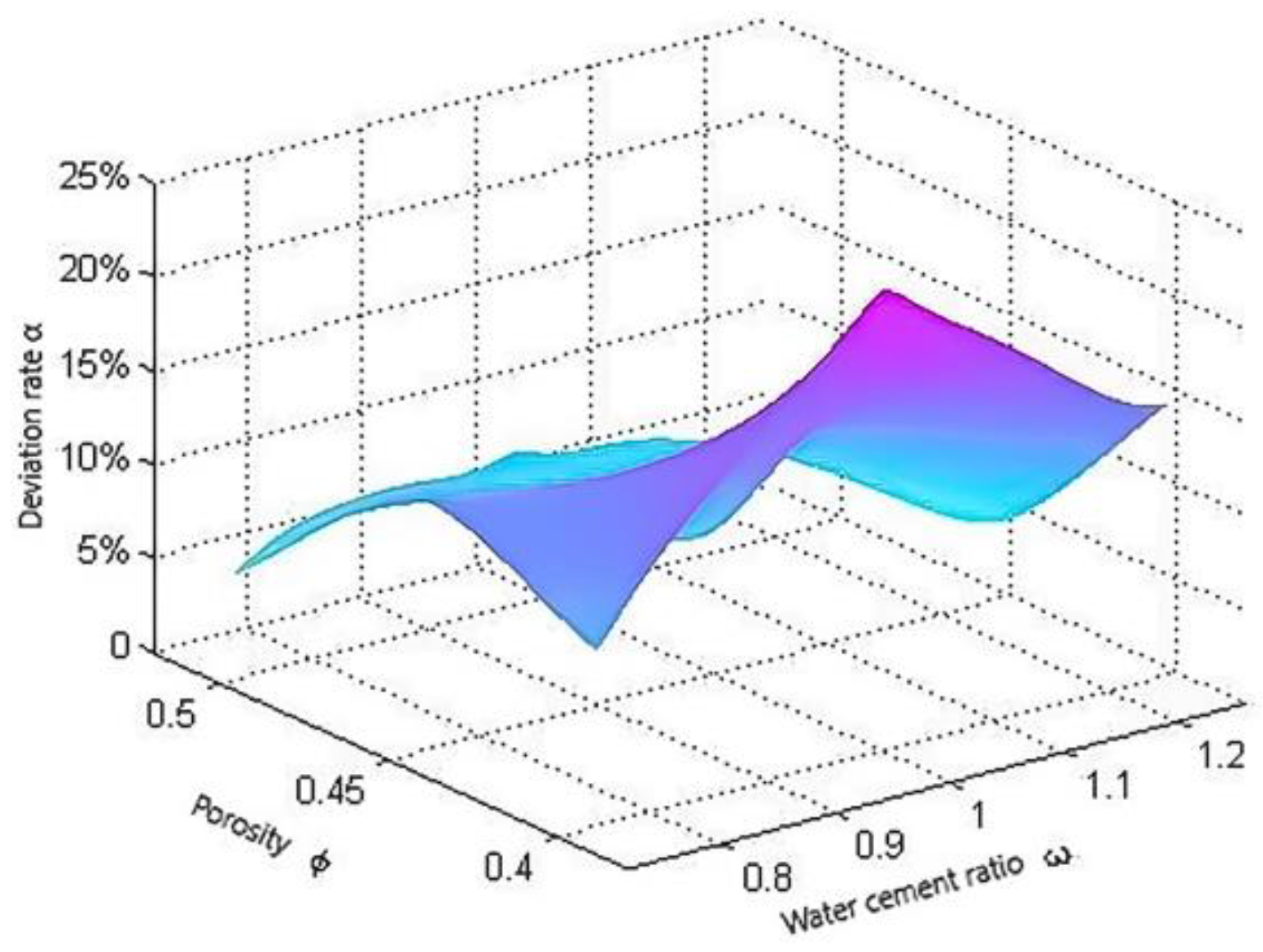Influence of Coupling Effects between Gravel Soil Porosity and Cement Grout Weight on Diffusion Laws and Morphologies of Penetration Grouting
Abstract
:1. Introduction
2. Experimental Studies
2.1. Experiment Device and Experiment Scheme
2.2. Penetration Diffusion Laws of Cement Grout in Gravel Soil
- (1)
- Beginning stage: Most of the cement grout diffused rapidly in the gravel soil from the grouting hole along the downward (especially vertical downward (gravity)) direction. A certain amount of cement grout diffused horizontally and laterally around the grouting hole, and only a very small amount of cement diffused to its upper area. In this stage, the cement grout diffusing along the downward direction was much larger than the cement diffusing around the grouting hole horizontally and laterally, both in terms of diffusion speed and diffusion volume.
- (2)
- Intermediate stage: both the diffusion speed and diffusion volume of cement grout in gravel soil along the downward direction gradually decreased; while the amount of cement grout diffusing horizontally and horizontally around the grouting hole slowly increased, and a certain amount of cement diffused into the gravel soil at the upper part of the grouting hole.
- (3)
- End stage: Only a very small amount of cement grout penetrated and diffused into the gravel soil at the lower part of the grouting hole. The speed and volume diffusing in the horizontal and lateral part around the grouting hole gradually decreased, while most of the cement penetrated and diffused in the upward direction at this stage.
2.3. Spatial Diffusion Morphology
2.4. Experiment Results
3. Effect of Coupling Effect of Porosity and Cement Grout Weight on the Diffusion Morphology of Penetration Grouting in Gravel Soil
3.1. Comparison between Experimental Values and Theoretical Values of Penetration Diffusion
3.2. Three-Dimensional Spatial Diffusion Morphology Model
3.3. Effect of Coupling Effect of Porosity and Cement Grout Weight on the Diffusion Morphology of Penetration Grouting in Gravel Soil
- 1.
- When α = 0, the diffusion of cement grout in gravel soil is spherical, and the three-dimensional spatial morphology is a standard sphere.This indicates that porosity and cement grout weight coupling effect have no influence on the diffusion morphology of penetration grouting in gravel soil, which is the assumption of cement penetration grouting diffusion theory in gravel soil and does not exist in actual grouting penetration diffusion.
- 2.
- When 0 ≤ α < 1, the coupling effect of porosity and cement grout weight has an effect on the diffusion morphology of penetration grouting in gravel soil, and the penetration grouting in gravel soil is ellipsoidal diffusion, and the three-dimensional spatial morphology is approximately ellipsoidal, which is consistent with the actual penetration grouting diffusion; the larger indicates that the effect of coupling effect of porosity and cement grout weight on the diffusion morphology of penetration grouting in gravel soil is also greater.
- The coupling effect of cement grout weight and porosity of Bingham-type cement has a more significant effect on the three-dimensional spatial diffusion morphology formed by infiltration in gravelly soil, especially in gravelly soil with porosity over 0.5.
- When the power-law cement is infiltrated into the gravel soil with porosity over 0.4, the coupling effect of its self-weight and porosity has a significant effect on its three-dimensional spatial diffusion morphology; while when the power-law cement is infiltrated into the gravel soil with porosity less than 0.4, the effect is not significant.
- Newtonian cement infiltration into gravelly soil with porosity less than 0.5, the coupling effect of cement grout weight and porosity, effect on its three-dimensional spatial diffusion morphology is not significant; only in the gravel soil with porosity over 0.5, the effect shows a more significant feature.
4. Theoretical Analysis
- When the gravel soil porosity ϕ is greater than 0.5, its internal pore size is large, and the majority of pore sizes are larger than the maximum particle size of cement (about 60–100 μm), and the gravitational effect of power law, Bingham and Newton type cement promotes its penetration diffusion in the pore space of gravel soil along the downward (especially vertical (y-axis) downward) direction, inhibiting the horizontal. This results in a difference of almost 10% between the diffusion size of the cement in the gravity (y-axis) direction and the diffusion size in the horizontal lateral (x-axis and z-axis) direction, especially for the Bingham-type cement in the gravelly soil, where the difference is nearly 25%.
- When the gravel soil porosity is in the range of 0.4 < ϕ < 0.5, the internal pore size is large and most of the pore sizes exceed the maximum particle size of the cement (about 60–100 μm), the gravitational effect of the power-law and Bingham-type cement has a better promotion effect on its penetration diffusion in the gravel soil pore space along the downward (especially vertical (y-axis) downward) direction, and it has a more severe inhibition effect on its penetration diffusion in the horizontal In contrast, Newtonian cement is relatively less dense, and its own gravitational effect on the diffusion in the gravel soil along the gravity (vertical downward, y-axis) direction is more than 5% different from that in the horizontal lateral (x-axis and z-axis) direction, while the Newtonian cement is relatively less dense, and its own gravitational effect on the diffusion in the gravel soil along the gravity (vertical downward, y-axis) direction is more than 5% different from that in the horizontal lateral (x-axis and z-axis) direction. The difference between the diffusion size of Newtonian cement in the gravity (y-axis) and horizontal (x-axis and z-axis) directions is within 5%, because of its gravitational effect on the diffusion in the gravity (vertical downward, y-axis) direction and the inhibition of the diffusion in the horizontal lateral (x-axis and z-axis) direction are both greatly weakened.
- When the gravelly soil has a porosity ϕ ≤ 0.4, the internal pore size is small and a part of it does not exceed the maximum particle size of the cement (about 60–100 μm).
- (a)
- When the cement is a power-law fluid, it has a strong gravitational effect due to its higher density, which promotes its penetration and diffusion in the gravel soil along the downward (especially vertical (y-axis) downward) direction and inhibits its penetration and diffusion in the horizontal lateral (x-axis and z-axis) direction in the beginning stage; as the grouting time goes on, the liquid is thicker and thicker due to the smaller water–cement ratio of this type of cement. At the same time, the pore size is smaller, causing most of the pores along the downward direction to be blocked by the cement, inhibiting its diffusion in the gravity (vertical downward, y-axis) direction and promoting its diffusion in the horizontal lateral (x-axis and z-axis) direction, thus resulting in a difference of less than 5% in the diffusion size in both directions.
- (b)
- When the cement is a Newtonian fluid, its gravitational effect is weak and the pore size between the gravelly soil is small, which has a less significant effect on its permeability diffusion along the downward (especially vertical (y-axis) downward) and horizontal transverse (x-axis and z-axis) directions of the gravelly soil, and therefore, the difference in diffusion size caused in these two directions is also less than 5%.
- (c)
- When the cement is Bingham fluid, its gravitational effect is between the gravitational effect of power-law and Newtonian cement, although the pore size inside the gravel soil is small and part of the pores along the downward direction are blocked by the cement, but in the process of penetration diffusion, in general, the gravitational effect of Bingham cement to promote its diffusion along the downward (especially vertical (y-axis) downward) is stronger than that due to part of the pores. The cement blockage and the small size of the pore space inhibit the diffusion; therefore, it results in a better diffusion of Bingham cement along the gravity (vertical downward, y-axis) direction than in the horizontal lateral (x-axis and z-axis) direction, with a large difference (more than 5%) in the diffusion size between the two.
5. Conclusions
- The diffusion pattern of penetration grouting in gravel soil: in the beginning stage, most of the cement slurry penetrates and diffuses rapidly in the gravel soil from the grouting hole along the downward (especially vertical downward due to gravity) direction; in the middle stage, the cement mainly penetrates and diffuses horizontally and laterally around the grouting hole; in the end stage, most of the cement penetrates and diffuses along the upward direction.
- The actual permeate diffusion size of cement in gravel soil is different from the theoretical diffusion value, and it shows a three-dimensional spatial diffusion morphology of nearly ellipsoid; its trajectory equation is quantitatively characterized, which can be used as a computational model for three-dimensional spatial diffusion size parameters, and thus can be used to predict the three-dimensional spatial diffusion size of cement permeate grouting in gravel soil in order to provide guidance for engineering practice.
- The deviation rate of three-dimensional spatial diffusion pattern of cement penetration grouting in gravel soil is defined, and the effect law of coupling effect between gravel soil porosity and cement grout weight on morphologies of penetration grouting is discussed. That is, for Bingham type cement slurry, when the porosity exceeds 0.5, the coupling effect has a significant effect on the three-dimensional spatial diffusion pattern of gravel soil penetration grouting; for power-law type cement slurry, when the porosity exceeds 0.4, the coupling effect has a significant effect, while less than 0.4 is showing insignificant characteristics; for Newton type cement slurry, the coupling effect has a comparable significant effect.
Author Contributions
Funding
Data Availability Statement
Conflicts of Interest
References
- The Compilation Group of Rock grouting theory and Engineering. Geotechnical Grouting Theory and Engineering Examples; Science Press: Beijing, China, 2001. [Google Scholar]
- Wang, G.-J. Grouting Technology Theory and Practice; China University of Mining and Technology Press: Beijing, China, 2000. [Google Scholar]
- Zhang, X. Study on Mechanism of Slurry Diffusion and Sealing at the Process of Underground Engineering Moving Water Grouting and Its Application; Shandong University: Jinan, China, 2011. [Google Scholar]
- Zou, J. Study on Grout Diffusion Theory and Residual Stress on Base Grouted Drilled Shaft; Zhejiang University: Hangzhou, China, 2010. [Google Scholar]
- Uddin, M.K. Permeation grouting in sandy soils: Prediction of injection rate and injection shape. Geotech. Eng. 2007, 38, 1–7. [Google Scholar]
- Li, S.-G. Research on Permeation Grouting Experiment and Application in Sandy Strata; Dongbei University: Shenyang, China, 2010. [Google Scholar]
- Yang, X.-Z. Study on Grout Diffusion Theory and Experiments under Static or Dynamic Loading. Ph.D. Thesis, Central South University, Changsha, China, 2005. [Google Scholar]
- Li, X.S.; Li, Q.H.; Hu, Y.J.; Teng, L.; Yang, S. Evolution Characteristics of Mining Fissures in Overlying Strata of Stope after Converting from Open-Pit to Underground. Arab. J. Geosci. 2021, 14, 2795. [Google Scholar] [CrossRef]
- Ye, F.; Liu, Y.-P.; Gou, C.-F.; Zhang, J.; Zhou, Z. Capillary penetration diffusion model for backfill grouting of shield tunnel. J. Southwest Jiao Tong Univ. 2013, 48, 428–434. [Google Scholar] [CrossRef]
- Ye, F.; Chen, Z.; Sun, C.-H.; Han, X.-B.; Yang, T.; Ji, M. Penetration diffusion model for backfill grouting through segments of shield tunnel considering weight of grout. Chin. J. Geotech. Eng. 2016, 38, 2175–2183. [Google Scholar] [CrossRef]
- Ye, F.; Chen, Z.; Jia, T.; Mao, Y.-F.; Mao, J.-H. Penetration diffusion model of exponential fluid for backfill grouting through segments of shield tunnel. Chin. J. Geotech. Eng. 2016, 38, 890–897. [Google Scholar] [CrossRef]
- Dayakar, P.; Raju, D.K.V.; Sankaran, B.S. Improvement of coarse grained soil by permeation grouting using cement based HPMC grout. Int. J. Emerg. Technol. Adv. Eng. 2014, 4, 17–22. [Google Scholar]
- Yang, P. Study on Simulation Grouting Experiment in Gravel & Mechanism of Penetration Grouting; Central South University: Changsha, China, 2005. [Google Scholar]
- Draganovic, A.; Stille, H. Filtration of cement-based grouts measured using a long slot. Tunn. Undergr. Space Technol. 2014, 43, 101–112. [Google Scholar] [CrossRef]
- Fang, G.; Xia, T.-D.; Bao, L.; Ye, J. Cement grout dispersion considering filtration in gravel. Chin. J. Rock Mech. Eng. 2013, 32, 1443–1448. [Google Scholar]
- Li, S.-C.; Zheng, Z.; Liu, R.-T. Analysis of diffusion of grout in porous media considering infiltration effects. Chin. J. Rock Mech. Eng. 2015, 34, 2401–2409. [Google Scholar]
- Tiruoatl, B. Experimental and Numerical Investigations of Chemical Grouting in Heterogeneous Porous Media. Ph.D. Thesis, University of Windsor, Windsor, ON, Canada, 2005. [Google Scholar]
- Bolisetti, T.; Reitsma, S.; Balachandar, R. Experimental investigations of colloidal silica grouting in Porous media. J. Geotech. Geo-Environ. Eng. 2009, 135, 697–700. [Google Scholar] [CrossRef]
- Wang, D.-L. Study on the Mechanism of Dynamic Water Chemical Grouting in Porous Media; China University of Mining and Technology: Xuzhou, China, 2011. [Google Scholar]
- Zhou, Z.L.; Du, X.M.; Chen, Z.; Zhao, S.L. Grouting diffusion of chemical fluid flow in soil with fractal characteristics. J. Cent. South Univ. 2017, 24, 1190–1196. [Google Scholar] [CrossRef]
- Zhang, L.-Z.; Zhang, Q.-S.; Liu, R.-T.; Li, S.-C.; Wang, H.-B.; Li, W.; Zhang, S.-J.; Zhu, G.-X. Penetration grouting mechanism of quick setting slurry considering spatiotemporal variation of viscosity. Rock Soil Mech. 2017, 38, 443–452. [Google Scholar] [CrossRef]
- Yang, Z.-Q. Theoretical and Experimental Study on Grouting of Cement Slurry in Small Particle Sand Body; Kunming University of Science and Technology: Kunming, China, 2008. [Google Scholar]
- Yang, Z.-Q.; Niu, X.-D.; Hou, K.-P. Study on Grouting Diffusion Parameters in the Gravel Soil. Rock Soil Mech. 2015, 36, 397–402. [Google Scholar]
- Yang, Z.-Q.; Hou, K.-P.; Liang, W. Study of diffusion parameters of Newtonian fluid based oncolumn-hemispherical penetration grouting. Rock Soil Mech. 2014, 35, 17–24. [Google Scholar]
- Yang, Z.; Niu, X.; Hou, K.; Guo, Y.; Zhou, Z.; Chen, F.; Kang, Y. Study on Diffusion Parameters of Bingham Fluid Based on Column-hemispherical Penetration Grouting. J. Sichuan Univ. 2015, 47, 47–53. [Google Scholar] [CrossRef]
- Yang, Z.-Q.; Hou, K.-P.; Guo, T.-T.; Ma, Q. Study of column-hemispherical penetration grouting mechanism based on Bingham fluid of time-dependent behavior of viscosity. Rock Soil Mech. 2011, 32, 2698–2703. [Google Scholar]
- Yang, Z.-Q.; Hou, K.-P.; Yang, B.-J. Study on column penetration gtouting mechanism based on Power-law cement grouts of time-dependent behavior. Chin. J. Rock Mech. Eng. 2015, 34, 1415–1425. [Google Scholar]
- Yang, Z.; Hou, K.; Guo, T. Study on the Effects of Different Water-cement Ratios on the Flow Pattern Properties of Cement Grouts. Appl. Mech. Mater. 2011, 72, 1264–1267. [Google Scholar] [CrossRef]
- Li, X.; Li, Q.; Hu, Y.; Chen, Q.; Peng, J.; Xie, Y.; Wang, J. Study on Three-Dimensional Dynamic Stability of Open-Pit High Slope under Blasting Vibration. Lithosphere 2022, 2022, 6426550. [Google Scholar] [CrossRef]





| Influencing Factors | Three-Dimensional Spatial Diffusion Dimensions of Cement in Gravelly Soil | |||
|---|---|---|---|---|
| Cement Water–Cement Ratio | Porosity of Gravelly Soil /% | Diffusion Dimension in y-axis Direction/cm | Diffusion Dimension in x-axis Direction/cm | Diffusion Dimension in z-axis Direction /cm |
| 1.0 | 50.74 | 12.2 | 9.2 | 9.8 |
| 0.75 | 45.05 | 6.8 | 5.9 | 6.6 |
| 1.25 | 39.93 | 12.0 | 11.5 | 11.8 |
| 0.75 | 50.74 | 8.4 | 7.8 | 7.6 |
| 1.25 | 45.05 | 12.5 | 12.0 | 12.3 |
| 1.0 | 39.93 | 11.1 | 10.6 | 10.3 |
| 1.25 | 50.74 | 13.8 | 12.7 | 11.8 |
| 1.0 | 45.05 | 12.1 | 11.8 | 11.2 |
| 0.75 | 39.93 | 6.8 | 6.5 | 6.6 |
| Theoretical Values of Penetration Diffusion Radius Obtained from the Penetration Grouting Diffusion Mechanism/cm | Equivalent Penetration Diffusion Sphere Radius Calculated from Experimental Measurements/cm | Difference between the Two Values/% |
|---|---|---|
| 6.9 | 10.4 | 33.65 |
| 8.5 | 6.4 | 24.71 |
| 37.9 | 11.7 | 32.48 |
| 18.0 | 7.9 | 56.11 |
| 13.7 | 12.3 | 10.22 |
| 3.6 | 10.7 | 66.36 |
| 27.2 | 12.7 | 53.31 |
| 7.0 | 11.7 | 40.17 |
| 7.7 | 6.6 | 14.29 |
| Water–Cement Ratio ω | Gravelly Soil Porosity ϕ /% | Length of Semi-Axis (Vertical Direction) a/cm | The Smaller of the x and z (Horizontal and Lateral) Semi-Axis Lengths min (b,c)/cm | Approximate Ellipsoidal Morphology Deviation Rate of Infiltration Grout Diffusion α/% |
|---|---|---|---|---|
| 1 | 0.5074 | 12.2 | 9.2 | 24.59% |
| 0.75 | 0.4505 | 6.8 | 5.9 | 13.24% |
| 1.25 | 0.3993 | 12 | 11.5 | 4.17% |
| 0.75 | 0.5074 | 8.4 | 7.6 | 9.52% |
| 1.25 | 0.4505 | 12.5 | 12 | 4.00% |
| 1 | 0.3993 | 11.1 | 10.3 | 7.21% |
| 1.25 | 0.5074 | 13.8 | 11.8 | 14.49% |
| 1 | 0.4505 | 12.1 | 11.2 | 7.44% |
| 0.75 | 0.3993 | 6.8 | 6.5 | 4.62% |
| Effect of Cement Grout Weight (Water–Cement Ratio ω) | ||||
|---|---|---|---|---|
| Power-Law Type Cement (ω ≤ 0.75) | Bingham Type Cement (0.75 < ω < 1.25) | Newton Type Cement (ω ≥ 1.25) | ||
| Gravelly soil porosity ϕ influence effect | ϕ ≤ 0.4 | Insignificant (α < 5%) | More significant (5% < α < 15%) | Insignificant (α < 5%) |
| 0.4 < ϕ < 0.5 | More significant (5% < α < 15%) | Insignificant (α < 5%) | ||
| ϕ ≥ 0.5 | More significant (5% < α < 15%) | Significant (15% < α < 25%) | More significant (5% < α < 15%) | |
Publisher’s Note: MDPI stays neutral with regard to jurisdictional claims in published maps and institutional affiliations. |
© 2022 by the authors. Licensee MDPI, Basel, Switzerland. This article is an open access article distributed under the terms and conditions of the Creative Commons Attribution (CC BY) license (https://creativecommons.org/licenses/by/4.0/).
Share and Cite
Yang, Z.; Liu, Y.; Chen, M.; Wang, X.; Ye, C.; Li, X.; Chen, W.; Yang, Y.; Wang, B.; Li, C.; et al. Influence of Coupling Effects between Gravel Soil Porosity and Cement Grout Weight on Diffusion Laws and Morphologies of Penetration Grouting. Appl. Sci. 2022, 12, 7601. https://doi.org/10.3390/app12157601
Yang Z, Liu Y, Chen M, Wang X, Ye C, Li X, Chen W, Yang Y, Wang B, Li C, et al. Influence of Coupling Effects between Gravel Soil Porosity and Cement Grout Weight on Diffusion Laws and Morphologies of Penetration Grouting. Applied Sciences. 2022; 12(15):7601. https://doi.org/10.3390/app12157601
Chicago/Turabian StyleYang, Zhiquan, Yuqing Liu, Mao Chen, Xiangpeng Wang, Changwen Ye, Xiaohui Li, Wentao Chen, Yi Yang, Bojun Wang, Chengjin Li, and et al. 2022. "Influence of Coupling Effects between Gravel Soil Porosity and Cement Grout Weight on Diffusion Laws and Morphologies of Penetration Grouting" Applied Sciences 12, no. 15: 7601. https://doi.org/10.3390/app12157601
APA StyleYang, Z., Liu, Y., Chen, M., Wang, X., Ye, C., Li, X., Chen, W., Yang, Y., Wang, B., Li, C., & Wang, J. (2022). Influence of Coupling Effects between Gravel Soil Porosity and Cement Grout Weight on Diffusion Laws and Morphologies of Penetration Grouting. Applied Sciences, 12(15), 7601. https://doi.org/10.3390/app12157601






